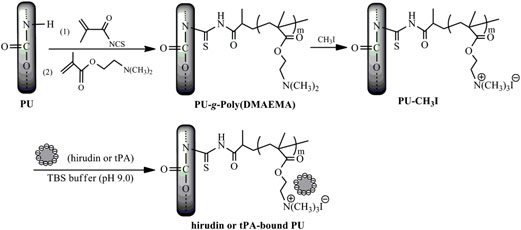Hemocompatible polyurethane surfaces
Polymers for Advanced Technologies,
2012,
23,
1500-1502.
文章链接:http://dx.doi.org/10.1002/pat.2072
武照强副教授在Polymers for Advanced Technologies发表研究论文
发布日期:2012-09-08
With the aim of improving the hemocompatibility of blood-contacting devices, antithrombotic or fibrinolytic biological molecules-containing polyurethane (PU) materials have been developed. Cationic PU surfaces were prepared by grafting poly(dimethylaminoethyl methacrylate) and quaternizing the tertiary amino groups with iodomethane. The surfaces were characterized by water contact angles and X-ray photoelectron spectroscopy. The materials (PU-CH3I) were treated with antithrombotic or fibrinolytic drugs, such as hirudin or tissue plasminogen activator (tPA) in Trisbuffered saline (pH 9.0) to yield hirudin-loaded or tPA-loaded PU surfaces. The hirudin and tPA quantity of the surfaces was observed using a radiolabeling method. The quantities of hirudin and tPA taken up by the cationic surfaces were significantly greater than those on the unmodified PU: approximately 200-fold greater for hirudin and 10-fold for tPA. The release of the bound hirudin and tPA from the materials in contact with plasma was slow, and at 48h, ~78% of the initial hirudin and ~26% of the initial tPA remained bound. The activity of the bound hirudin and tPA, as measured by a plasma recalcification assay, was largely preserved. This approach may have potential for the development of surfaces having antithrombotic or fibrinolytic properties.

